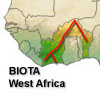 



Weather data
A large number of automatic weather stations has been implemented in the frame of the BIOTA AFRICA project by the Namibian National Botanical Research Institute (NBRI) and the Group "Biodiversity, Evolution and Ecology" (BEE) of the University of Hamburg. The website offers hourly updates of data and graphs of a large number of weather parameters.

|
 BIOTA West Africa - Workpackage - CT1-T1-WP4
BIOTA West Africa - Workpackage - CT1-T1-WP4
Core Topic (CT) |
The contemporary status of biodiversity in West Africa and concepts for its sustainable conservation |
Topic (T) |
Local to national scale |
Title |
 Evaluation of Protected Areas - Towards strategies for conservation and sustainable development
Evaluation of Protected Areas - Towards strategies for conservation and sustainable development
|
Project leader(s) |
Dr. Karen Hahn-Hadjali & Prof. Dr. Rüdiger Wittig
Prof. Dr. Elisabeth Kalko & Jakob Fahr
Prof. Dr. K. Eduard Linsenmair
Prof. Dr. Mark Oliver Rödel & Johannes Penner
Prof. Dr. Jürgen Runge & Konstantin König
Dr. Nikolaus Schareika
Dr. Michael Schmidt & Dr. Tobias Landmann
Prof. Dr. Brice Sinsin
Prof. Dr. Adjima Thiombiano
Prof. Dr. Paul L. G. Vlek & Dr. Ulrike Falk
Prof. Dr. Georg Zizka, Dr. Stefan Dressler & Marco Schmidt
|
Project description |
1. Evaluation of the current status of biodiversity in PAs
A Gap Analysis aims at the identification of additional PAs necessary to complement the current network of national PAs in order to cover a maximum level of biodiversity. The analysis will form the basis to rank existing as well as additionally needed PAs as a priority setting-tool for governmental interventions and to define the next steps towards an efficient conservation strategy on the national level. These analyses will be linked to the Gap Analysis on regional to continental scales, striving for coordinated international and transboundary strategies for biodiversity conservation in West Africa
2. Improving fire management in PAs
In regards to park management, one critical issue is to improve the understanding of different fire regimes and their impact on the maintenance of biodiversity. Fire is a frequently applied management tool, however, up to date sound scientific data for evaluating its long-term effects are lacking.
3. Socio-political dimension of PAs
The socio-political and socio-economic dimensions of PAs have to be analysed to answer central questions: How can local people be integrated into protection measures? Is the concept of buffer zones a viable option which focuses on sustainable use of natural resources at different intensities around the strictly protected core areas? Under what conditions and constraints do West African states manage and develop PAs? How is state legislation concerning PAs realised at the local level? How can income be generated by focusing on gender aspects? Ultimately, this larger framework aims at recommendations for park management in which local populations become engaged in conservation, rather than being perceived as opponents to it.
|
|
|






 Go to the WeatherNet
Go to the WeatherNet BIOTA West Africa - Workpackage - CT1-T1-WP4
BIOTA West Africa - Workpackage - CT1-T1-WP4 Evaluation of Protected Areas - Towards strategies for conservation and sustainable development
Evaluation of Protected Areas - Towards strategies for conservation and sustainable development